1993 CHEVROLET CAVALIER coolant level
[x] Cancel search: coolant levelPage 108 of 308
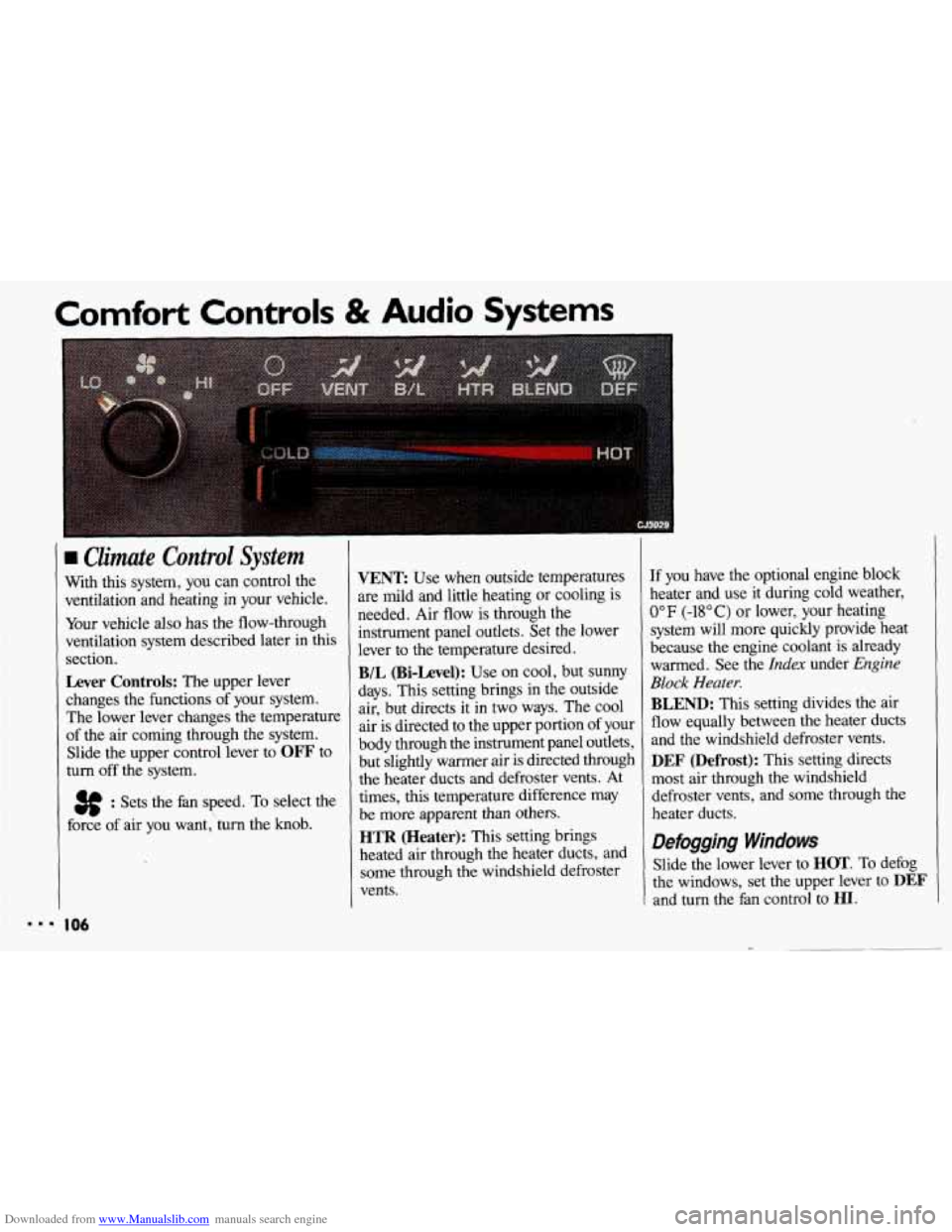
Downloaded from www.Manualslib.com manuals search engine Comfort Controls & Audio Systems
Climate Control System
With this system, you can control the
ventilation and heating in your vehicle.
Your vehicle
also has the flow-through
ventilation system described later in this
section.
Lever Controls: The upper lever
changes the functions of your system.
The lower lever changes the temperature
of the air coming through the system.
Slide the upper control lever to
OFF to
turn
off the system.
3f : Sets the fan speed. To select the
force of air you want,'turn the knob.
I06
VENT Use when outside temperatures
are mild and little heating or cooling is
needed. Air flow is through the
instrument panel outlets. Set the lower
lever to the temperature desired.
B/L (Bi-Level): Use on cool, but SUMY
days. This setting brings in the outside
air, but directs it in
two ways. The cool
air is directed to the upper portion of your
body through the instrument panel outlets,
but slightly warmer air is directed through
the heater ducts and defroster vents. At
times, this temperature difference may
be more apparent than others.
HTR (Heater): This setting brings
heated air through the heater ducts, and
some through the windshield defroster
vents.
If you have the optional engine block
heater and use it during cold weather,
0°F (-18°C) or lower, your heating
system will more quickly provide heat
because the engine coolant is already
warmed. See the
Index under Engine
Block Heater.
BLEND: This setting divides the air
flow equally between the heater ducts
and the windshield defroster vents.
DEF (Defrost): This setting directs
most air through the windshield
defroster vents, and some through the
heater ducts.
Defogging Windows
Slide the lower lever to HOT. To defog
the windows, set the upper lever to
DEF
and turn the fan control to HI.
Page 110 of 308
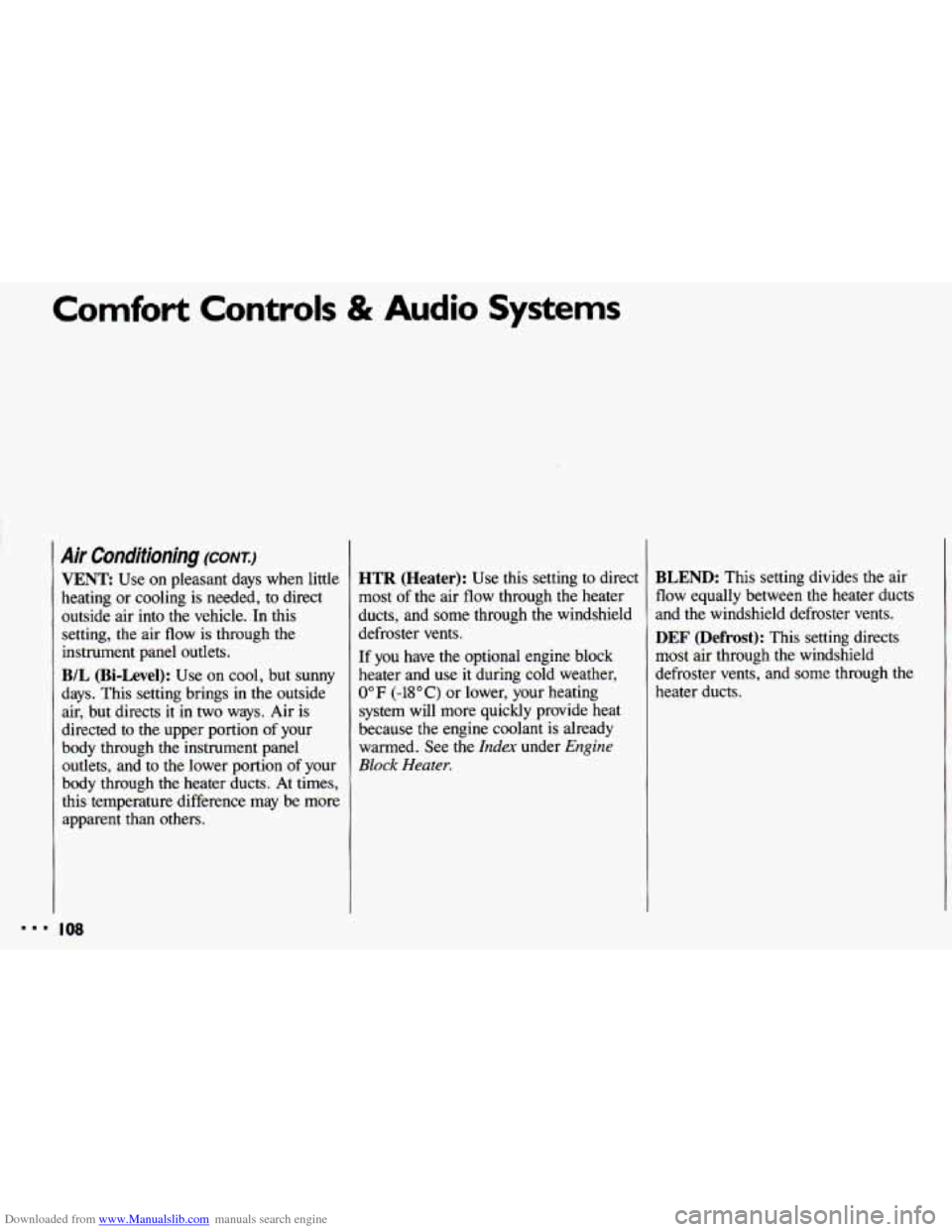
Downloaded from www.Manualslib.com manuals search engine Comfort Controls & Audio Systems
Air Conditioning (CONX:)
VENT Use on pleasant days when little
heating or cooling is needed,
to direct
outside air into the vehicle.
In this
setting, the air flow
is through the
instrument panel outlets.
B/L (Bi-Level): Use on cool, but sunny
days. This setting brings in the outside
air, but directs it in two ways. Air is
directed to the upper portion
of your
body through the instrument panel
outlets, and to the lower portion of your
body through the heater ducts. At times,
this temperature difference may be more
apparent than others.
HTR (Heater): Use this setting to direct
most of the air flow through the heater
ducts, and some through the windshield
defroster vents.
If
you have the optional engine block
heater and use
it during cold weather,
0°F (-18°C) or lower, your heating
system will more quickly provide
heat
because the engine coolant is already
warmed. See the
Index under Engine
Block Heater.
BLEND: This setting divides the air
flow equally between the heater ducts
and the windshield defroster vents.
DEF (Defrost): This setting directs
most air through the windshield
defroster vents, and some through the
heater ducts.
Page 178 of 308
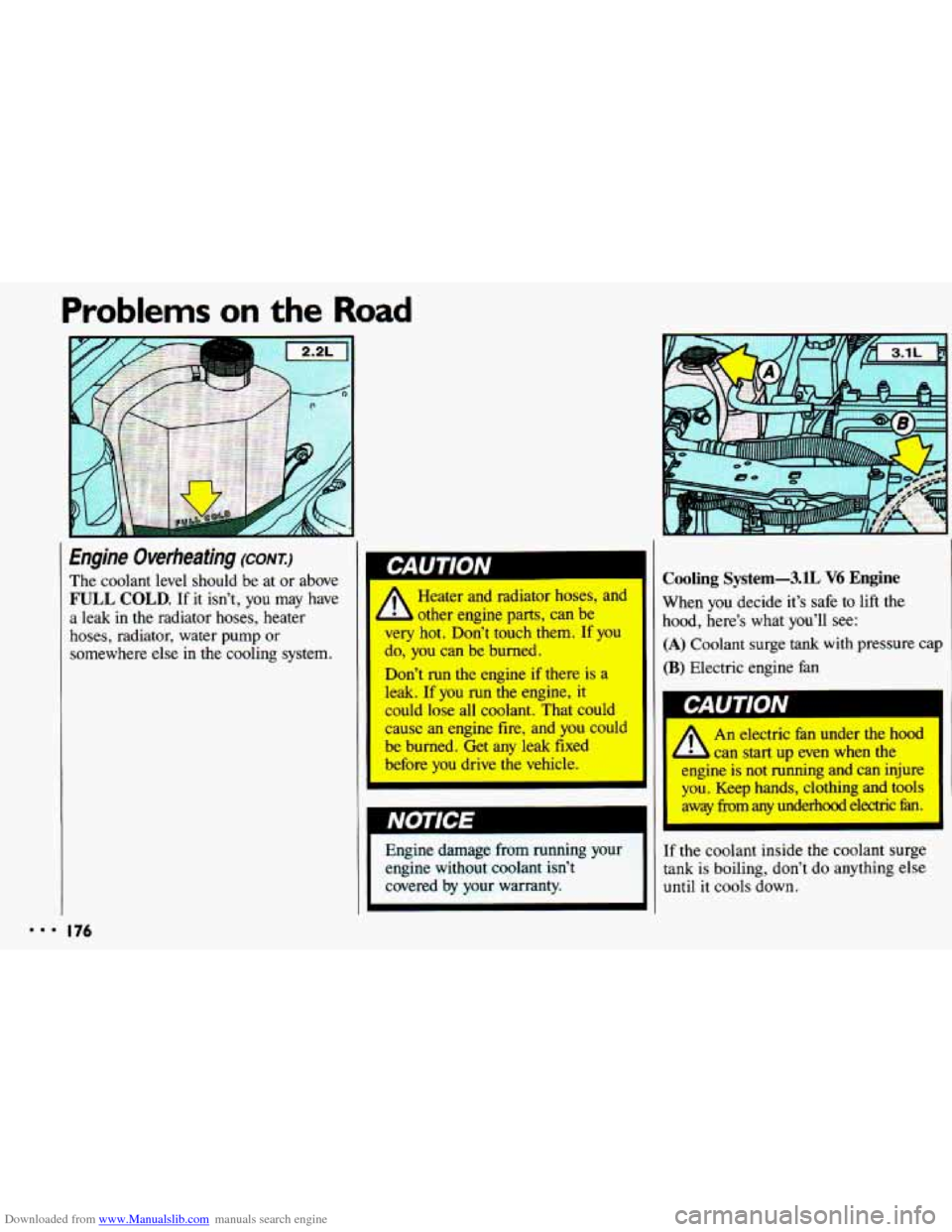
Downloaded from www.Manualslib.com manuals search engine Problems on the Road
Engine Overheating (CONT.)
The coolant level should be at or above
FULL COLD. If it isn't, you may have
a leak
in the radiator hoses, heater
hoses, radiator, water pump
or
somewhere else in the cooling system.
II Heater and radiator hoses, and
L other engine parts, can be
very hot. Don't touch them. If you
do, you can be burned.
Don't run the engine if there is a
leak. If you run the engine, it
could
lose all coolant. That could
cause
an engine fire, and you could
be burned. Get any leak fixed
before you drive the vehicle.
Engine damage from running
your
engine without coolant isn't
covered by your warranty.
I
Cooling System-3.1L V6 Engine
When you decide it's safe to lift the
hood, here's what you'll see:
(A) Coolant surge tank with pressure cap
(B) Electric engine fan
An electric fan under the hood
L can start up even when the
engine
is not running and can injl
you. Keep hands, clothing and tows
away hm any underhood electric f8n. I
If the coolant inside the coolant surge
tank is boiling, don't do anything else
until it cools down.
I.. I76
Page 179 of 308
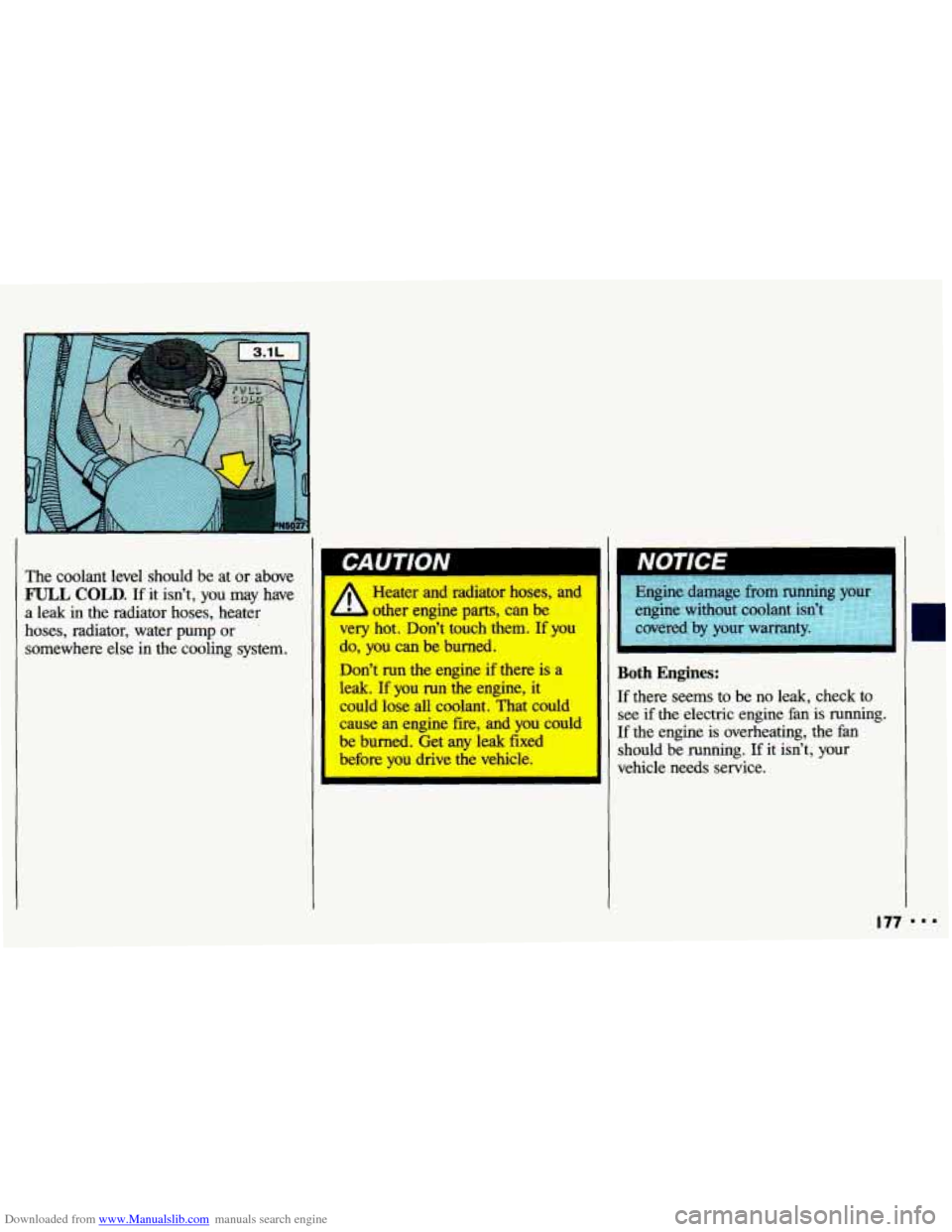
Downloaded from www.Manualslib.com manuals search engine The coolant level should be at or above
FULL COLD. If it isn’t, you may have
a leak
in the radiator hoses, heater
hoses, radiator, water pump
or ’
somewhere else in the cooling system.
, Heater and radiator hoses, and
- b other engine parts, can be
very hot. Don’t touch them.
If you
do,
you can be burned.
Don’t run the engine
if there is a
leak.
If you run the engine, it
could lose all coolant. That could
cause
an engine fire, and you could
be burned. Get any leak
fixed
before you drive the vehicle.
Both Engines:
If there seems to be no leak, check to
see
if the electric engine fan is running.
If the engine is overheating, the fan
should be running. If it isn’t, your
vehicle needs service.
I77 I..
Page 180 of 308
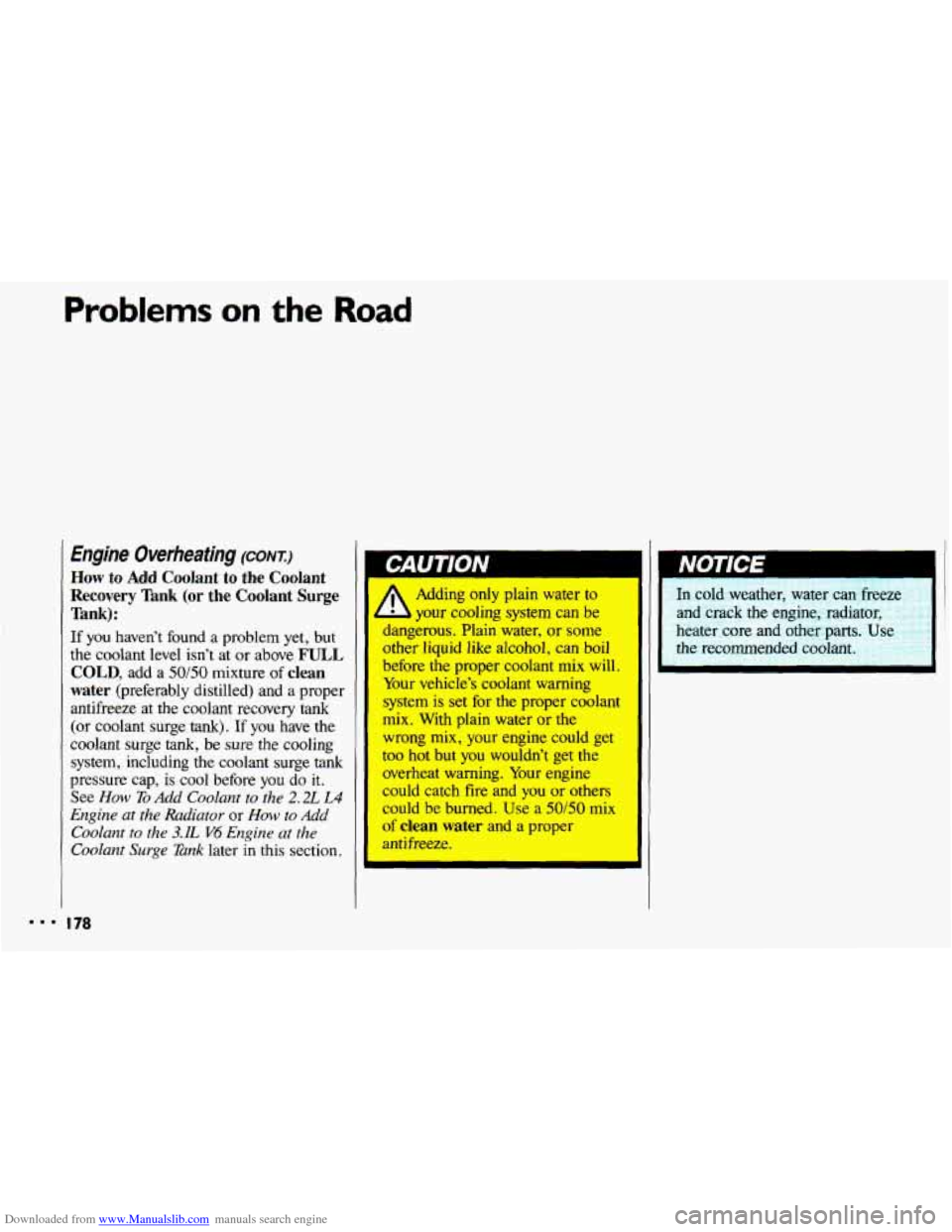
Downloaded from www.Manualslib.com manuals search engine Problems on the Road
Engine Overheating (CONT.)
How to Add Coolant to the Coolant
Recovery Tank
(or the Coolant Surge
Tank):
If you haven’t found a problem yet, but
the coolant level isn’t at or above FULL
COLD,
add a 50/50 mixture of clean
water
(preferably distilled) and a proper
antifreeze at the coolant recovery
tank
(or coolant surge tank). If you have the
coolant surge tank, be sure
the cooling
system, including the coolant surge
tank
pressure cap, is cool before you do it.
See How To Add Coolant to the 2.2L L4
Engirze at the Radiator or How to Add
Coolant
to the 3.1L V4 Engine ut the
Coolant
Surge Tank later in this section.
A
Adding only plain water to
your cooling system can be
dangerous. Plain water, or some
other liquid like alcohol, can boil
before the proper coolant mix will.
Your vehicle’s coolant warning
system
is set for the proper cool an^
mix. With plain water or the
wrong
mix, your engine could get
too hot but you wouldn’t get
the
overheat warning, Your engine
could catch fire and you or others
could be burned. Use a 50150 mix
of clean water and a proper
antifreeze. In cold weather, water can freezt
and crack the engine, radiator,
heater core and other parts Ise
the recommended coolant.
mmm I 78
Page 183 of 308
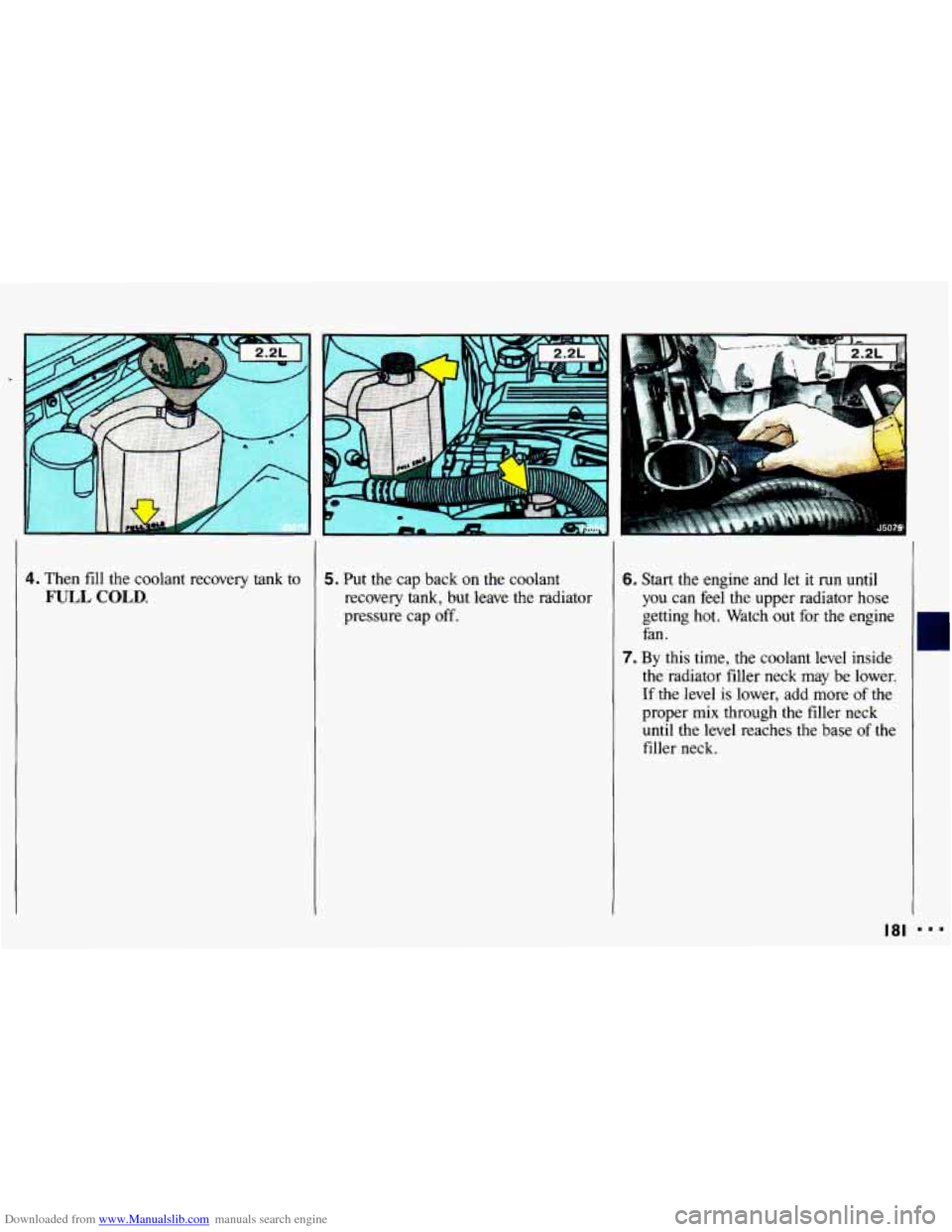
Downloaded from www.Manualslib.com manuals search engine 4. Then fill the coolant recovery tank to
FULL COLD.
5. Put the cap back on the coolant
recovery tank, but leave the radiator
pressure cap off. 6. Start the engine and let it run until
you can feel the upper radiator hose
getting hot. Watch
out for the engine
fan.
7. By this time, the coolant level inside
the radiator filler neck may be lower.
If the level is lower, add more of the
proper mix through
the filler neck
until the level reaches the base
of the
filler neck.
I81
Page 185 of 308
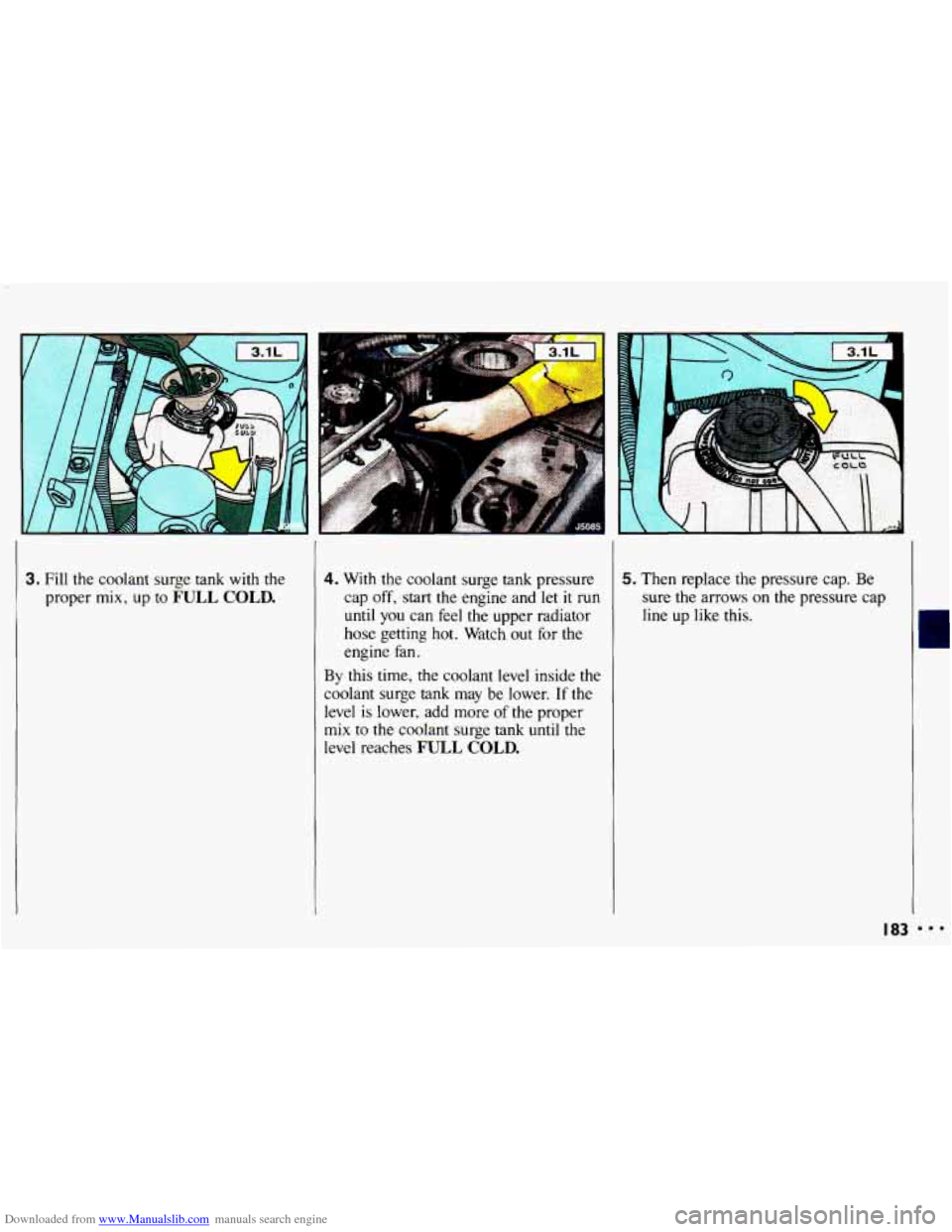
Downloaded from www.Manualslib.com manuals search engine 3. Fill the coolant surge tank with the
proper
mix, up to FULL COLD.
4. With the coolant surge tank pressure
cap
off, start the engine and let it run
until you can feel the upper radiator
hose getting hot. Watch out for
the
engine fan.
By this time, the coolant level inside the
coolant surge tank may be lower. If the
level
is lower, add more of the proper
mix to the coolant surge tank until the
level reaches
FULL COLD.
5. Then replace the pressure cap. Be
sure the arrows on the pressure cap
line up like this.
I83 ...
Page 197 of 308
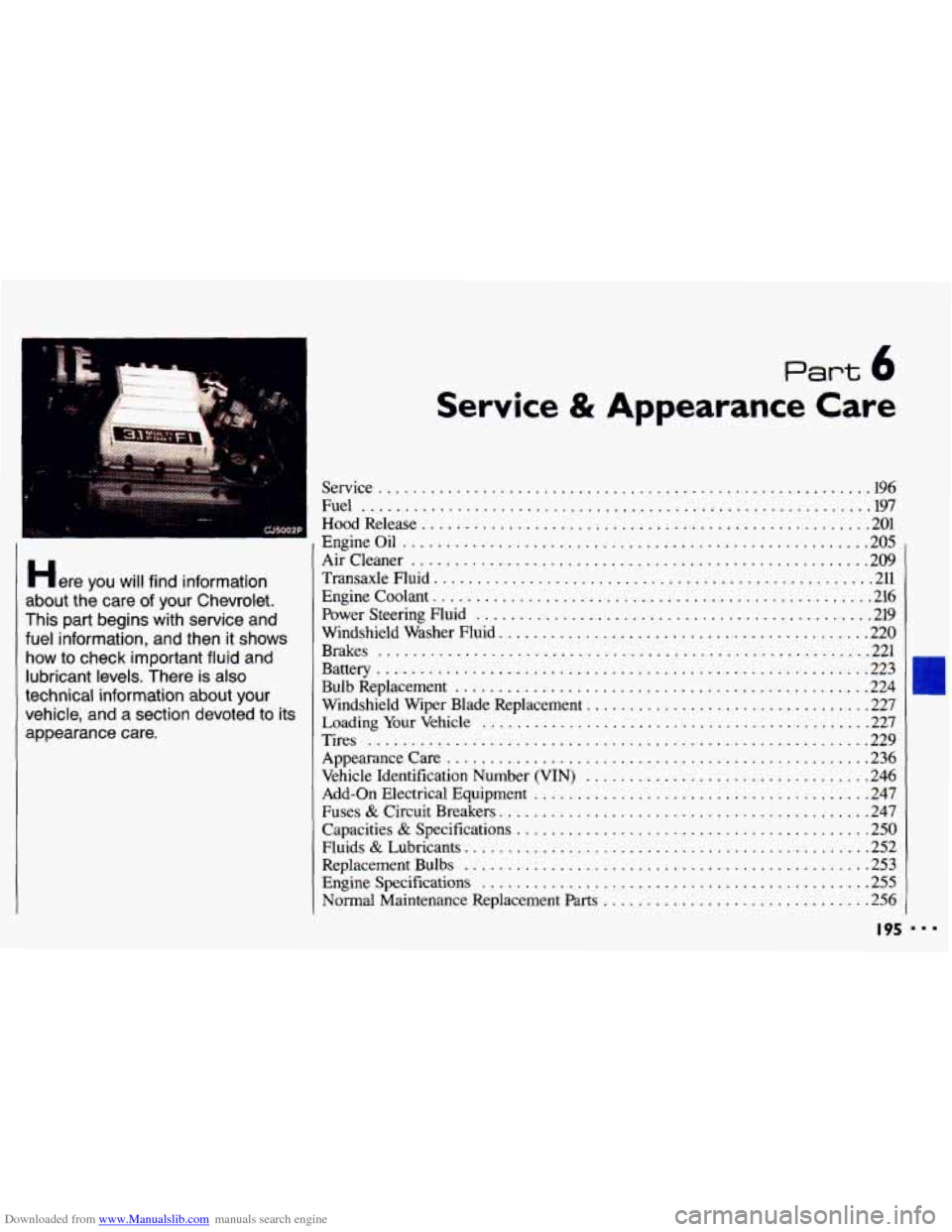
Downloaded from www.Manualslib.com manuals search engine i
.....
.................................. ...................
........ ... . &5
..... ..... .... .. --
' . I .. ~
Here you wit1 find information
about the care
of your Chevrolet .
This part begins with service and
fuel information. and then
it shows
how to check important fluid and
lubricant levels
. There is also
technical information about your
vehicle. and
a section devoted to its
appearance care
.
Part 6
Service & Appearance Care
Service ......................................................... 196
Fuel ........................................................... 197
HoodRelease
.................................................... 201
EngineOil
...................................................... 205
Aircleaner
..................................................... 209
Transaxle Fluid
................................................... 211
Engine Coolant
................................................... 216
Power Steering Fluid
.............................................. 219
Windshield Washer Fluid
........................................... 220
Brakes
......................................................... 221
Battery
......................................................... 223
BulbReplacement
................................................ 224
Windshield Wiper Blade Replacement
................................. 227
Loading
Your Vehicle ............................................. 227
Vehicle Identification Number (VIN)
................................. 246
Add-on Electrical Equipment
....................................... 247
Fuses
& Circuit Breakers ........................................... 247
Capacities & Specifications ......................................... 250
Fluids & Lubricants ............................................... 252
Replacement Bulbs
............................................... 253
Engine Specifications
............................................. 255
Normal Maintenance Replacement
Parts ............................... 256
Tires .......................................................... 229
Appearancecare
................................................. 236
I95